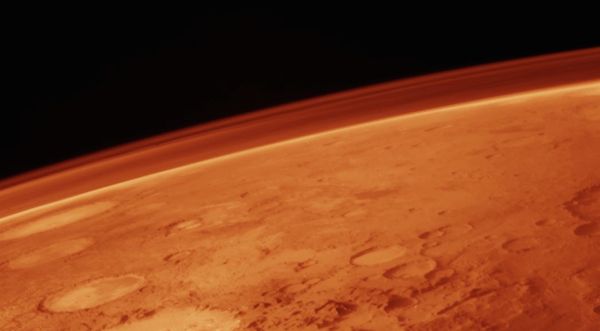
[Image above] Credit: NASA

Impact glass can form at the site where a meteorite strikes the earth and serve as a tiny time capsule of environmental conditions at the time of impact. Credit: Brown University
Has life ever existed on Mars?
Scientists have figured out an interesting new way to investigate that question—and it involves glass.
When meteoroids strike the earth, they do so with tons (often literally) of force—which can generate enough heat and pressure to melt rocks and materials on the Earth’s surface. If the strike occurs in sand, like in a desert, the silica particles can fuse to form a kind of glass called impact glass, some of which are beautiful. (Interestingly, a similar phenomenon can also happen when lightning strikes sand, although it doesn’t look anything like that depicted in the movie “Sweet Home Alabama.”)
According to a Geology.com article, “Usually only the very largest crater-forming events generate the energy required to melt, fragment, or even vaporize terrestrial rocks. Luckily for the inhabitants of planet Earth, such events are extremely rare and most known impactites are relics of meteoritic strikes from the distant past.”
But whether old or new, impactites, which include impact glass, can be found on Earth’s surface. Scientists studying ancient meteorite impacts have now found that impact glass can preserve bits of organic matter, acting like a tiny time capsule that provides an environmental snapshot of the time of impact.
The scientists, led by geologist and Brown University professor Pete Schultz, collected and studied samples from an area of Argentina that contains impact glass that formed from multiple meteorite impacts between 6,000 and 9 million years ago. The scientists observed well-preserved structures and chemical signatures of tiny bits of plant materials from impact glass samples that were 3 million and 9 million years old. “We know these were major impacts because of the shocked minerals trapped inside with plant materials,” says Schultz in a Brown press release. “These glasses are present in different layers of sediment throughout an area about the size of Texas.”
To confirm their findings, the scientists also mimicked meteorite impact conditions in the lab by heating crushed impact glass combined with organic material. When rapidly heated to temperatures of 1500°C, organic plant matter was well preserved within the impact glass. Schultz thinks that’s because water on the outside layer protects the inside. “The outside of the leaves takes it for the interior,” he says in the press release. “It’s a little like deep frying. The outside fries up quickly but the inside takes much longer to cook.”
Scientists speculate that if such preservation can occur on Earth, a similar situation could also have happened on Mars. “And the soil conditions in Argentina that contributed to the preservation of samples in this study are not unlike soils found on Mars,” states the press release.
“Impact glass may be where the 4 billion-year-old signs of life are hiding,” Schultz says. “On Mars they’re probably not going to come out screaming in the form of a plant, but we may find traces of organic compounds, which would be really exciting.”
The work, titled “Preserved flora and organics in impact melt breccias,” is published in Geology.
Author
April Gocha
CTT Categories
- Aeronautics & Space
- Environment
- Glass
- Weekly Column: “Other materials”

